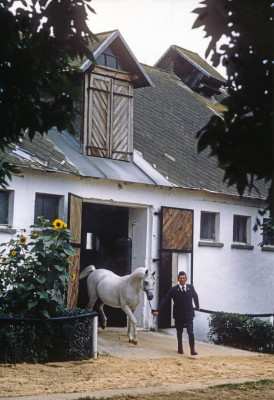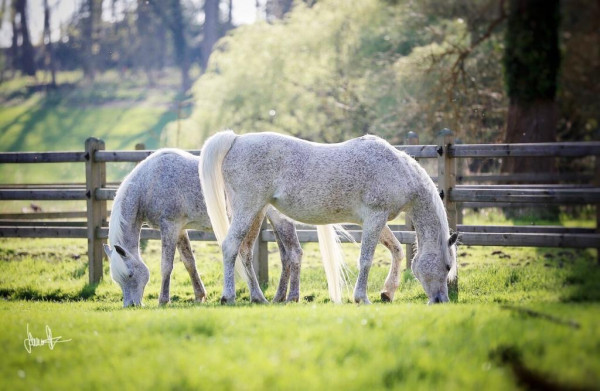Happy, Lively, Kind and Attentive – The Arabian Disposition
by Johanna Ullstrom
The Arabian horse is special in so many ways, and much has been written about its stamina, elegance and beauty.
But beyond that, what makes them stand out is the way they are. They crave human companionship. It is easy to see that the thousands of years in the harsh deserts have had an influence – survival depended on the ability to cooperate with humans, both in war and in camp. The selection was hard and ruthless. Intelligent, soft, courageous and strong horses, those that could be of use under the difficult circumstances of battles, starvation, sandstorms, heat and lack of water. Human and horse depended on each other.
This relationship can still be felt today. These horses have an intense interest in humans, in a different way than most other breeds. Arabians blossom when they manage to have a close relationship with their people.
They eagerly try to communicate and are very receptive if we try to be sensitive enough to express ourselves in a way they can understand. An Arabian horse who manages to create a bond with its person is mostly very tolerant, steady and trustworthy, even in situations where many other horses would struggle.
On the other hand, if there is no trust, the Arabian tends to be frustrated and confused and can be intolerant and worried about small details. It’s a question of teamwork - having each others’ backs.
 Johanna Ullstrom with the stallion RP Burj Al Arab
Johanna Ullstrom with the stallion RP Burj Al Arab
(WH Justice x Pamira Bint Psytadel).
This makes the Arabian horse an incredible family horse, who will do his best whatever we ask, it’s all up to us. The master/slave relationship rarely works, but asking “would you please?” can make the Arabian go through fire for you!
With the Arabian’s high intelligence level there is also a big difference in attitude towards a task, if he can understand it well. This is not a horse who blindly obeys without reflection.
It might take a bit of kind explanation, encouragement and praise, especially with youngsters, but when not using force, they are very easy to convince, and will perform the task with both joy and pride before long. The more the trust grows, the tighter the relationship and the easier it is to perform anything and everything!
A meaningful relationship with an Arabian horse is built on companionship, mutual respect in its true form, and willingness to refine the communication and understanding with minimal pressure from both sides.
The common techniques used worldwide today that make “come to me and stay with me/follow me,” the easiest way, meaning pressure will stop/no running needed, etc., is not especially suited to our breed. These techniques often result in a light form of learned helplessness, accompanied by a sour face – long nostrils and ears back while the horse is working.
On the other hand, when working with an Arabian horse in freedom, full of life, glittering eyes and total connection, with the free choice of where to move around, the horse tends to choose to follow, and stay with the human of its own free will, not because he will be chased if he doesn’t follow! This is so typical for our breed!
When we do not interfere with/ruin their incredible and unique desire for wanting to stay around us, we are given so much for free, and it creates so much joy!
When a relationship of mutual trust is created, and both sides feel that the other side is sincerely trying to understand, even though their languages are from different worlds, the closeness and communication skills will deepen on both sides.

The awareness from both that there is a curious and honest try from the other side, both by expression and body language, is an inducement to try even harder, watch each other more carefully, be more consistent and show more kind respect towards one another.
And the more sensitive and refined we become in our communication, the easier it will be for the horse to understand and reply – which I think erases the common idea of us “teaching the horse,” when instead, the horse tends to understand us better the more WE learn to be sensitive and attentive!
When I meet a new horse, and start to work together, I try to think about what the horse can see and feel. He is there, guessing in the dark. I’m there, knowing what I mean, but of course he does not! So, I must try to put myself in his situation, watch myself through his eyes. We are very different, of course. But we do want to communicate. How can I appear logical to him? How can I make sense to him when I explain? And how can I be interesting?
I would like him to light up when he sees me, to crave our moments, to enjoy and eagerly guess, out of my clumsy tries, what I am trying to say. He will always remain the more refined and sensitive one. Talking and explaining in a way he can and wants to understand is my goal, as well as trying to understand what he needs to express.
And that requires me to stay totally open to him of course, watching him, trying to understand his body language and face, meet him somewhere in our minds – at first for short moments, very cloudy and misty, but once connecting, we both want to get back there, so it comes faster and easier each time.
With connection, I mean that we are utterly aware of each other and can feel each other’s mind well, kind of what two best friends, or relatives can feel when they see each other. It is like a joint emotion. When I keep myself aware of this, I can more easily work on myself to get better.
I have so much power in each situation, as the horse is a domesticated animal that cannot choose to leave me to just run away into the wild if he wants, but he’s curious about me, also a little suspicious and above all, confused, as we are so different.

I choose to use my power by giving both freedom and choice to him, and I welcome him into my language. In exchange, he’s teaching me his own! We will never speak fluently, but we can improve each day.
Initially, I just want him to know I want him well, and that there is no rush. When an Arabian horse can feel we only have two minutes of time, it often takes two hours. But instead, when he feels we have hours of time, no rush at all, it is often done in two minutes! They are incredibly sensitive to our mood and mindset.
I can feel that the horse has a sort of relief, when realizing that communication is possible, that there is a chance to express worry, discomfort, pain, joy, anger, excitement or confusion, without being helpless, but instead, having a chance of response and solution.
Our horses are aware that there is a chance of response. This gives them a certain harmony and inner calm, instead of helpless frustration. We can do so much good for our horses if we just stay aware, instead of labeling certain behaviors as “problem” behaviors without reflecting why.
This unique disposition of our beloved Arabian horse – happy, lively, kind and attentive – is so precious, a gift from the past.
There is no doubt that the Arabian horse has a high desire for engagement with us in comparison with most other breeds. He is highly intelligent, reflective and entertaining. We must treasure and preserve these qualities. Since our breed is pure, and not mixed, we cannot bring it back easily if we ruin it.


























